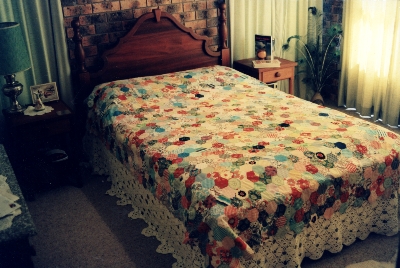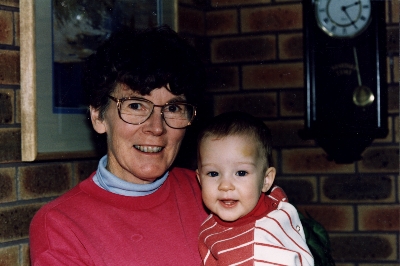Quilt No.360MS - Margery Smith

2300 x 1840mm
Made in the late 1960s - early 1970s by Margery Smith of Tumut (NSW), and owned by her.
"The quilt was completed on 23/7/1973 when the date was stitched on. The project took about three years using what time I had available.
At that time I had a terminally ill daughter. Each afternoon when the weather was suitable I laid her on a bean bag with her legs in the sun to strengthen them. Whilst I sat talking to her I made the patchwork quilts.
I had bags of scraps from many years of sewing for my daughters and myself. This was a way to utilize them.
First I cut a stiff cardboard template then using it as a pattern I cut hundreds of stiff paper hexagons (I had all my family saving stiff paper, glossy magazines were great.) Next all the material scraps were sorted and pressed. The template was again used to cut each piece to shape leaving a turning all round.
Each piece of material was carefully turned in and tacked to a prepared paper pattern. As all pieces of a material were used they were put into boxes. I had decided to keep to a theme in order to distribute the various materials through the quilts. This stage seemed to take forever. I had worked out approximately how many 'patches' I would need.
So to the more interesting part, and it really did take forever! A centre was chosen usually checked gingham as I had a lot of those, six patterned pieces were hand stitched around each centre. I soon got back to using a thimble as the finger developed a 'hole'.
When these were done all had to be joined and the missing patch inserted, again usually the checked gingham. Removing all the tacking and papers was no small chore but the quilts were taking shape.
After that came the unbleached calico linings, stitch, stitch, stitch, then presto all was done.
I had made a separate 'sham' to cover the pillow for the bedspread, a large cot cover and also a top for a bedroom stool.
Nowadays my daughters look at the quilts and pick out their school uniforms, dresses they wore to birthday parties, socials and other nostalgic occasions. Their sister's frocks too, especially a blue one that matched her eyes. When she had her black curls tied back with a matching ribbon my middle daughter used to say, 'Oh you do look nice when you are all clean and paid for'. That saying came from my Grandmother. Really a patchwork quilt is one way of recording family history."
[Notes from Margery Smith, 1998.]

Related Quilts:
1900 x 1900mm
1956 x 1677mm
2050 x 1250mm
1900 x 1930mm
1580 x 1510mm






